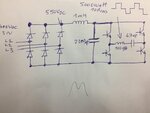rxpu
Member level 3

I constructed the following phase shift full bridge converter. Tried various passive filter combinations before and after the rectifier bridge. But the crest factor is really bad. Attached are the simulation results of phase voltage vs. current.
Any ideas how to improve the crest factor especially with passives filters?.
Should I use active power factor correction to get an improvement for the crest factor.
Will active power factor correction solve this problem (crest factor) completely?.


Any ideas how to improve the crest factor especially with passives filters?.
Should I use active power factor correction to get an improvement for the crest factor.
Will active power factor correction solve this problem (crest factor) completely?.








